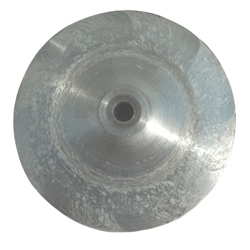Turbochargers Vehicle Operation Faults.
The majority of Turbochargers Vehicle Operation Faults, come from problems with the vehicles oil.
Oil is one of the most crucial determinates of Turbocharger health and longevity.
And a Turbocharger is the most sensitive engine sub-component, to a vehicles oil problems.
Oil starvation and/or contaminated oil, do the most damage to a Turbocharger during operation.
So Turbocharger Oil Systems are very Important.
When a turbocharger is internally diagnosed for a fault, where oil is the problem, scoring and ‘blueing’ of the shaft is typical.
This gives a clear diagnosis of an oil-related fault.
In the case of a vehicle operation fault involving oil, either there has been missed or late services.
Or when a service (with oil completely drained) was completed, the turbocharger was not pre primed, prior to re-start.
However, the oil system can still cause Turbocharger faults (even with regular services), if the engine suffers from “incorrect” or “incomplete” combustion.
And there are any number of causes for “Incorrect Combustion” such as:
EGR Valve Problems.
Diesel Particulate Filter DPF Problems.
Injector and Injector Seal Problems.
Leaks in Turbocharger piping, connections, flanges and intercoolers.
And ‘incorrect’ combustion leads to a host of other faults, as you will see in the section below on “Excessive Carbon Build Up”.
Alternatively, and regardless of servicing, the engine oil system is heavily contaminated by age, and needs to be completely flushed.
A complete flush includes dropping the oil sump pan, and cleaning the oil pick up, and an oil flush additive utilized.
Common factors in Turbocharger Operational Faults
Aside from the above oil Turbocharger Vehicle Operation Faults, there are a number of other Turbocharger Operation Faults.
MAF or other engine Sensor Faults:
MAF sensor faults or dirty sensors.
If the ECU receives incorrect data on air flow for example, turbocharger operation will be affected.
‘Turbocharger’ Noise and lack of power:
Sometimes a Turbocharger fault is assumed when a ‘squealing’ noise is heard, coupled with low throttle response.
There are a number of issues associated with these two symptoms:
1) Air and Gas leaks.
There are vacuum hoses (on pneumatically actuated turbos), air pipes (intake, intercooler), and flanges on a turbocharger and associated sub-systems.
The noise may be from air or gas (exhaust), leaking or being sucked in (under vacuum).
These breaches can happen at pipe connections, pipe splits, compressor and turbine housing flanges, intercooler hoses and intercooler body seams.
2) Damage to impeller or turbine blades.
Even small nicks caused by “Foreign Object Damage” (FOD), will cause noise and vibration at 100,000 plus rpm.
Lack of power with or without Engine Check light:
Another overlooked issue relates to the condition of the EGR(Engine Gas Re-circulation) Valve and DPF (Diesel Particulate Filter).
Incorrect VNT Actuation and Excessive Carbon Build Up:
If the vane geometry inside the turbocharger is not correct for the engine speed, Turbocharger performance will vary, and you might get a ‘squealing’ noise.
This can be a fault with the actuator or Boost Control Solenoid (in pneumatic applications), but is usually associated with excessive carbon build up in the VNT assembly.
Excess carbon build up or ‘coking’ is explained in more detail under EGR Valve Problems.
Over-speeding and Loose Impeller Nuts:
Overspeeding occurs when the Turbocharger is unable to supply enough air to the engine.
The turbocharger has to work harder to push the extra air required.
And in doing so, the Turbocharger is forced to work above its design parameters.
A common reason for overspeeding is gas or air leaks.
For example, the Hyundai iLoad 2.5L Diesel is known for intercooler leaks.
Air escaping from a seam in the intercoooler, induces the engine to demand more from the Turbocharger, and the Turbocharger overspeeds as a result.
Obviously, the above applies to any Turbocharged vehicle, with or without an intercooler.
Leaks or restrictions can happen in the vacuum and induction pipes, due to splits or loose fittings at flanges, and restricted flow from blocked air filters.

Another common cause of overspeeding is a jammed wastegate or VNT assembly.
If the Turbocharger is not able to easily ‘dump’ gasses, boost levels will spike.
A spike in boost will cause numerous problems, but overspeeding can be the most damaging.
Where this happens too often and without rectification, the compressor(most notably) and other internals, like bearing become weakened over time.
The ECU in modern vehicles usually comes to the rescue, by enabling ‘Limp Mode’ to protect the engine, and sub-components like the Turbocharger.
But if the vehicle has had a re-map (especially a poor one), and the parameters for boost and hence ‘Limp Mode’ have been extended, the Turbocharger will suffer catastrophic failure.
In such catastrophic failures, the shaft and bearings completely jam at high speed, or the compressor disintegrates.
In cases where the shaft jams at high speed, the Turbocharger stops spinning abruptly.
When the Turbocharger stops spinning abruptly, the shaft may snap, and the Impeller or Compressor Nut can actually spin off.
The physics of a compressor(impeller) nut coming undone are complex, as the torqued-on nut has a reverse thread to spin direction.
Basically, if the turbo is operating under usual conditions, the nut cannot spin off due to oppositional torque.
Again, it is highly recommended that the induction system, intercooler and flanges are checked for leaks.
As you can see there are a number of operational factors affecting Turbochargers.
For a more comprehensive list of Turbocharger Failure Indicators, click here.
